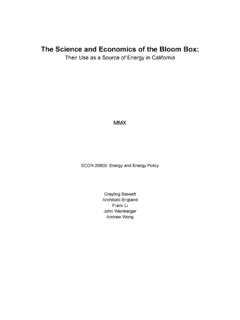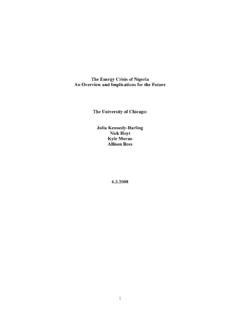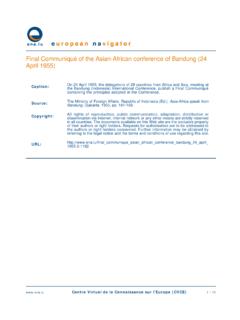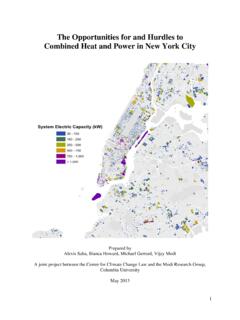Transcription of Combined Heat and Power Systems
1 Combined heat and Power Systems : Identifying Economic and Policy Barriers to Growth Adil Kalam, Abigail King, Ellen Moret, Upekha Weerasinghe Adil Kalam, Abigail King, Ellen Moret, Upekha Weerasinghe Consultant: Michael Roytburd Energy and Energy Policy Fall Quarter 2009 2 Table of Contents Executive Policy Economic Analysis Part One: Statistical Analysis of State Analysis Part Two: Cost Benefit Conclusions and Appendix A Regression Appendix B STATA Regression Appendix C Cost and Performance Appendix D Capital Appendix E O&M Appendix F Basic Cost Appendix G Levelized Cost 3 Executive Summary Combined heat and Power Systems can provide a range of benefits to users with regards to efficiency, reliability, costs and environmental impact. Furthermore, increasing the amount of electricity generated by CHP Systems in the United States has been identified as having significant potential for impressive economic and environmental outcomes on a national scale.
2 Given the benefits from increasing the adoption of CHP technologies, there is value in improving our understanding of how desired increases in CHP adoption can be best achieved. These obstacles are currently understood to stem from regulatory as well as economic and technological barriers. In our research, we answer the following questions: Given the current policy and economic environment facing the CHP industry, what changes need to take place in this space in order for CHP Systems to be competitive in the energy market? We focus our analysis primarily on Combined heat and Power Systems that use natural gas turbines. Our analysis takes a two pronged approach. We first conduct a statistical analysis of the impact of state policies on increases in electricity generated from CHP system . Second, we conduct a Cost Benefit analysis to determine in which circumstances funding incentives are necessary to make CHP technologies cost competitive.
3 Our policy analysis shows that regulatory improvements do not explain the growth in adoption of CHP technologies but hold the potential to encourage increases in electricity generated from CHP system in small scale applications. Our Cost Benefit analysis shows that CHP Systems are only cost competitive in large scale applications and that funding incentives would be necessary to make CHP technology cost competitive in small scale applications. From the synthesis of these analyses we conclude that because large scale applications of natural gas turbines are already cost competitive, policy initiatives aimed at a CHP market dominated primarily by large scale (and therefore already cost competitive) Systems have not been effectively directed. Our recommendation is that for CHP technologies using natural gas turbines, policy focuses should be on increasing CHP growth in small scale Systems .
4 This result can be best achieved through redirection of state and federal incentives, research and development, adoption of smart grid technology, and outreach and education. 4 Introduction New Era of Energy Production The United States faces daunting pressures on the energy market. In the past decade, demand for electricity has increased, as have retail prices and fuel costs for electricity production. In the United States, Americans consume over three times as much electricity per year than they did 50 years ago. In 2006, electricity consumption per capita was 13,583 kWh per yeari. And while the United States consumes nearly 25 percent of the world's energy, our population comprises only 5 percent of the world's population. Other issues affecting this marketplace are constraints on traditional electricity supply and delivery, global competition, climate change concerns, a failing grid infrastructure, and security issues.
5 Growing Pressures Electricity consumption has risen by 14% in the past ten years, going from approximately billion kWh per day in 1998 to approximately billion kWh per day in 2008. As demand for electricity increases, so have average prices per kWh, exerting increasing pressure on the energy situation. The residential sector saw prices rise from cents per kWh in 1998 to cents per kWh in 2008. As fuel costs for generating electricity have risen in the past decade from to from 1998 to 2008, so have end use prices. Figure 1: Electricity Consumption in kWh Per Capita 1960 20016 Figure 2: Average Retail Prices of Electricity 1960 2005 5 The picture is clear; the needs affordable solutions to combat increasing cost and demand pressure in electricity markets. Energy efficiency is understood to be the cornerstone of improving our future energy portfolio. Installing energy efficient technologies like commercial and industrial CHP are cost negative.
6 Combined heat and Power technology is one of the most appealing energy efficiency measures available to us today; it can lower overall energy demand, reduce reliance on fuel for generation, increase the competitiveness of businesses, cut green house gas emissions, and reduce the pressure for electricity grid infrastructure improvements. Combined heat and Power , or CHP, is an immediately employable solution that can address the growing constraints on America s energy future. The CHP Process Combined heat and Power describes any system that simultaneously or sequentially generates electricity and recovers and re uses the thermal energy byproduct of this process. CHP Systems have huge energy efficiency improvements because they produce two forms of useful energy heat and electricity, from a single fuel source. CHP extracts more useful energy from one fuel source than do the combination of processes that occur at traditional Power plants that produce electricity and separate facilities that produce In comparison with a standard Power plant, which operates at about 45% efficiency, a CHP facility operates at 80% efficiency.
7 CHP facilities extract this energy through two main types of Power cycles known as topping and bottoming cycles. The topping cycle, also known as a Combined cycle, is the most widely used and applied technology. A topping cycle system uses fuel to Power the primary process of generating electrical Power . Then the excess heat from this process is harvested and used directly to heat air or water, or as an energy source for heat driven cooling A bottoming cycle uses the primary fuel source to drive a heating mechanism. The excess heat from this process is then used to generate electricity for on site use or to sell back to the electrical grid. As the electricity grid becomes more focused on clean, renewable, efficient energy and moves away from a focus on centralized Power plants, on site Power generation, known as Distributed Generation, is garnering increasing attention. Many types of CHP applications are forms of Distributed Generation.
8 Typically, smaller scale CHP Systems produce a portion of the electricity needed by a facility some or all of the time on site, with the balance of electric needs satisfied by purchase from the grid. CHP as a form of distributed generation increases efficiency in two important ways. First, the system itself recovers waste heat to generate more KWH per unit of fuel. Second, generating electricity on site reduces the amount of energy lost in transmitting electricity. Figure 1: Fuel Costs for Electricity Generation 1996 2007 6 Modern History of CHP Despite widespread use of CHP technology in the early 1900s, the technology s share of the energy portfolio fell to 4% by As technology became more reliable and cost effective, grid infrastructure transitioned to centralized utility generators and CHP was abandoned in favor of more convenient purchased electricity. But with the introduction of the Public Utilities Regulatory Policy Act of 1978 (PURPA) interest in CHP was renewed.
9 PURPA included measures to promote CHP by offering incentives to utilities that purchased a portion of their Power from distributed generation In the 1980s CHP grew rapidly at large industrial facilities with significant on site heat and electricity demands. By the late 1990s the federal government realized that distributed generation facilities, particularly CHP Systems , were a cost effective way to meet rising energy needs. As a result, the Environmental Protection Agency and the Department of Energy have singled out CHP as an object of funding and attention and committed to increasing CHP capacity to 92GW by 2010. As of 2007, CHP facilities have been installed at 3,364 sites and have increased in total generating capacity from 46GW in 1998 to 85GW as of Growing CHP Combined heat and Power is a proven, well established technology with a long history in the Installed capacity has increased from less than 10 in 1980 to 85 GW in 2006.
10 But as a percentage of the overall Power grid, this technology has not made substantial gains. CHP currently accounts for approximately of total United States electricity generating capacity (MW)vii and of the electricity generation (MWh)viii. The greatest portion of current installed CHP capacity is in the industrial sector and is the segment with the greatest potential for growth. Other areas for growth in CHP capacity include district energy Systems , in which a central plant distributes steam to a network of locations, and small scale Systems in individual buildings. Advocates for energy efficiency have set a goal of increasing CHP capacity to 20% by 2030. Substantial additions like these to the electricity grid over the next twenty years will be influenced most heavily by two main factors: decreasing production costs and increasing favorable policies. The biggest challenges facing the CHP industry are due to unfavorable state energy policies.












